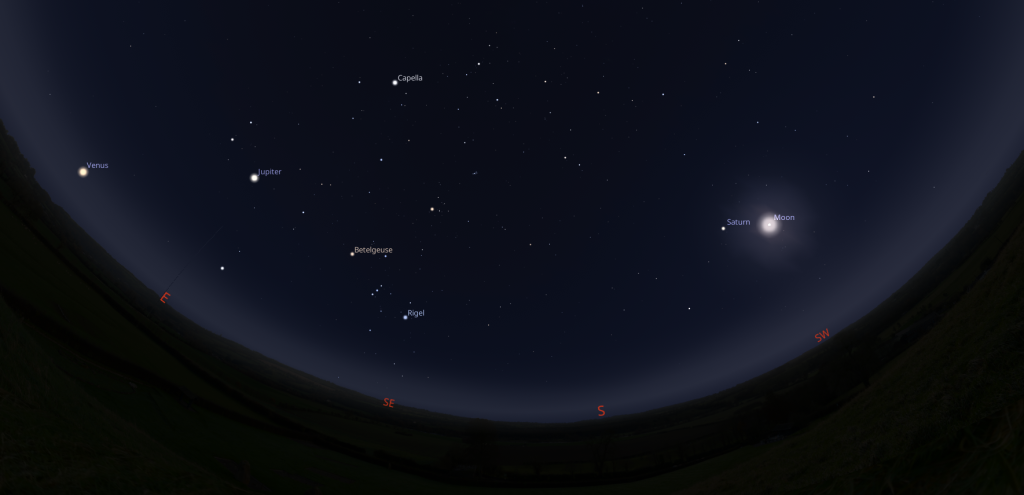As our days grow shorter and our nights longer, September should provide us with ample opportunities to view the stars. Sunrise will be at 6:40 AM at the start of the month and at 7:20 AM by the end of September, while sunset will move from 8:10 PM to 7 PM as the month progresses. The crisp Autumn air leads to clearer skies and improved visibility, and we are truly heading into Autumn with the Autumnal equinox taking place this month on September 22nd. Let’s take a look at all September has in store, starting with the equinox.
The Autumnal Equinox
The word equinox comes from Latin words translating to equal and night, which refers to the equal length of day and night during this time. On the day of an equinox, the Earth’s axis is not tilted toward or away from the Sun, resulting in equal hours of daylight and darkness across the world. The Autumnal equinox marks the beginning of astronomical Autumn for us in the Northern Hemisphere and on this day the Sun will rise directly in the east and set directly in the west. Around this date is when we see the biggest decrease in the amount of daylight we see each day as the Sun moves toward the Southern Hemisphere. If you were an observer on either of Earth’s poles, the Sun would move essentially horizontal to the horizon, neither rising nor setting. These effects last for several days, leaving you in a constant sunrise or sunset.
Earth is not the only planet that experiences an equinox. Any planet that is tilted on its axis of rotation will see these effects too. Apart from Mercury, this means every planet in our solar system has its own equinoxes and solstices. We can easily observe when an equinox occurs on Saturn. Its ring-system is usually tilted and allows us to view the rings quite easily through telescopes. During an equinox however, the rings are placed edge-on facing the Sun and we view them as just a thin line from Earth. These occur every 15 years, with the last one taking place on 6th May 2025 and lasting for weeks around that date. If we can spot an equinox on another planet, why not try to notice the changes in the Sun’s movements and daylight here on Earth as we approach the Autumnal Equinox on September 22nd.
A Total Lunar Eclipse
On September 7th, we will be treated to a full moon and a total lunar eclipse. This occurs when the Sun, Earth, and Moon align so that the Moon passes into Earth’s shadow. In a total lunar eclipse, the entirety of the Moon falls within the darkest part of Earth’s shadow, called the umbra. During totality, it appears a deep red/brown and these lunar eclipses are sometimes called “Blood Moons” because of this phenomenon. For observers in Ireland, the eclipse will begin when the Moon is still below the horizon, but as the sun sets in the west look east to watch the moon rising. As it rises, we will see the second half of the eclipse as the shadow of Earth slowly fades from the Moon’s surface. For best viewing, make sure you have a clear view of the horizon with no trees or buildings in the way and if possible, head to higher ground to allow you to see as much of the eclipse as you can. On September 8th, Saturn will pass very close to the Moon, located to its bottom right by sunset. In the early hours of September 16th and 19th respectively, the Moon will pass directly overhead Jupiter and Venus. The Moon moves very quickly through the sky, so only use the Moon as a marker to find the planets on those dates.
The Planets
This month there will be many planets to try and observe while you’re out doing your moongazing. Let’s look at where they will be on September 7th. Looking east just after 9 PM, we should see Saturn to the left of the Moon and low to the ground as it starts to rise above the horizon. It will stay visible all night long until the Sun rises again and it fades into the blue sky in the southwest.
Much later into the night, after 2 AM, we will see Jupiter trailing behind Saturn, also rising in the east. Jupiter will also stay visible for the rest of the night, moving southward as the hours progress. We will then see Venus join them after 4 AM as it makes its way above the horizon in the east. If you are awake at this hour, you will be treated to a beautiful view of the sky facing south with the Moon, Saturn, Jupiter, Venus and many bright stars and constellations visible.
So, if you were planning on observing the Moon’s partial lunar eclipse, why not try and find some of the planets while you’re at it. They should all be relatively bright compared to the stars and they will not twinkle like starlight does.

The Sky at 5 AM on the morning of September 8th. Image credit: Stellarium.
Space Week
It’s time to start getting ready for Space Week! Space Week will be taking place from October 4th – 10th. Students, families, community groups and members of the public will come together with the space community, the educational community, artists, astronomers and space scientists to use the powers of creativity, critical thinking, science, technology, engineering and maths to focus on the wonders and realities of the Universe around us. If you’re interested in attending an event, head to the Space Week website to see what’s on in your area.
During Space Week, everyone in Ireland is invited to organise an event. If you are a school, club, organisation or anyone organising an event for Space Week, you can quickly and easily add your event to the site to let people know about it. Events can be large or small, public or private, free to enter or with an entrance charge.
Wishing you clear and starry skies!
Blog post written by Jane Dooley


